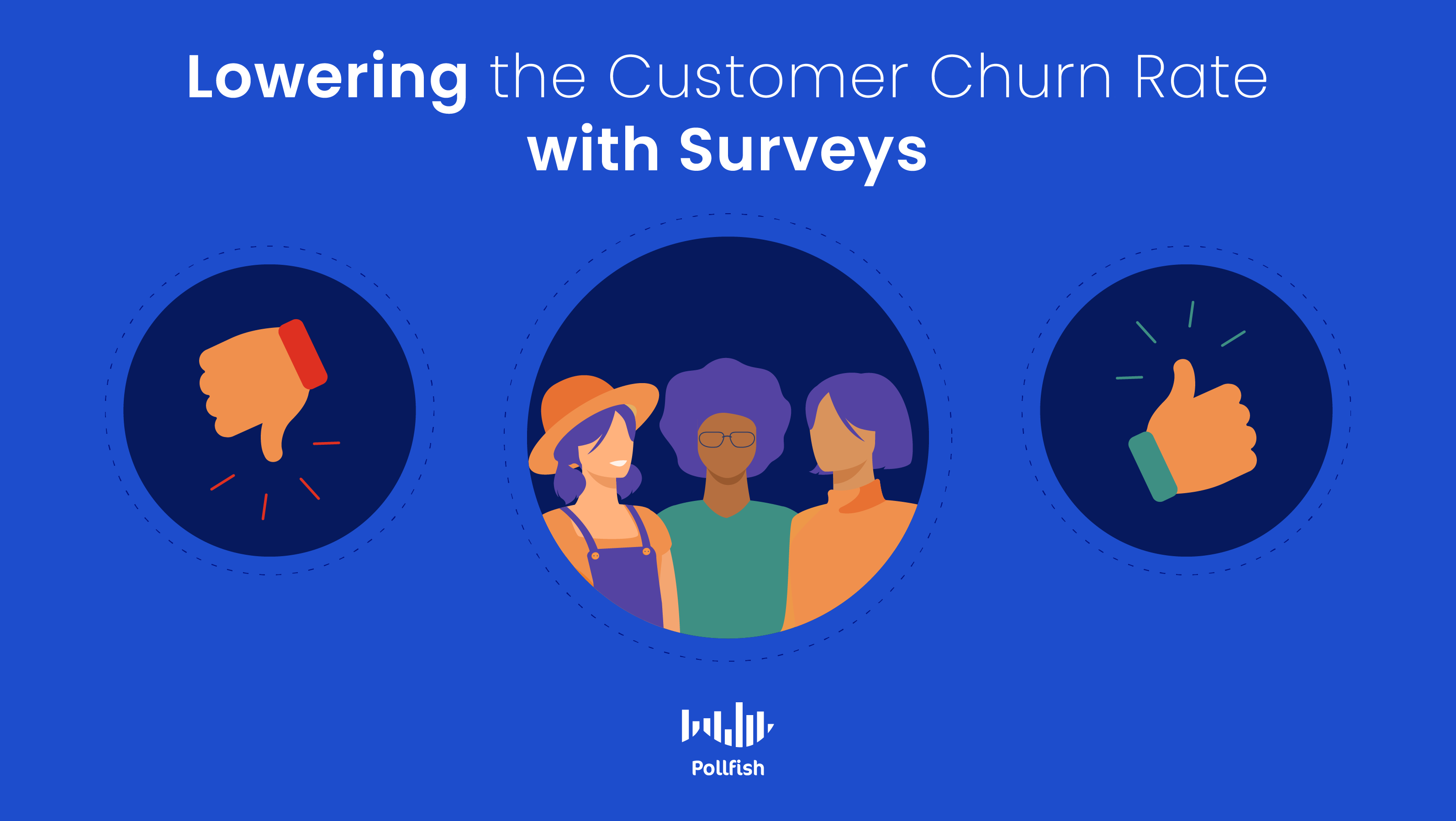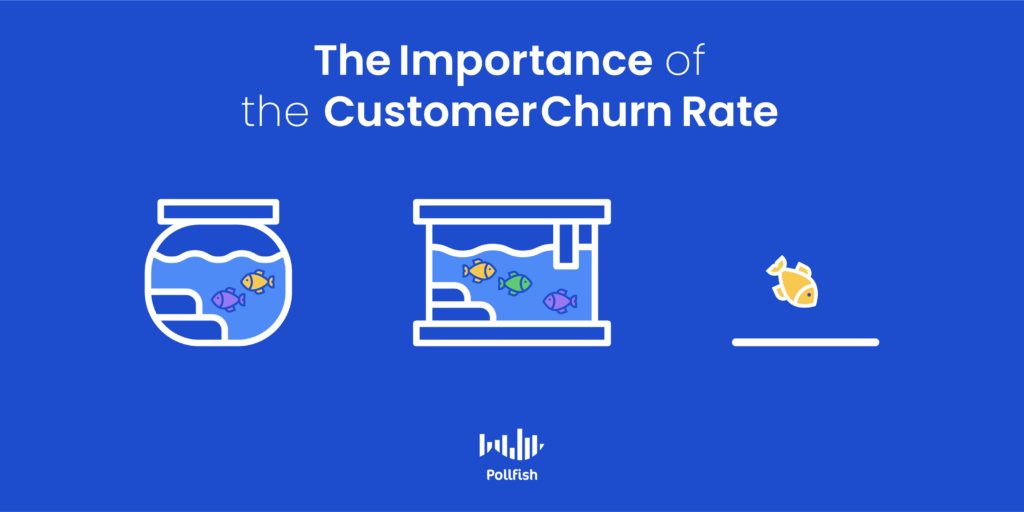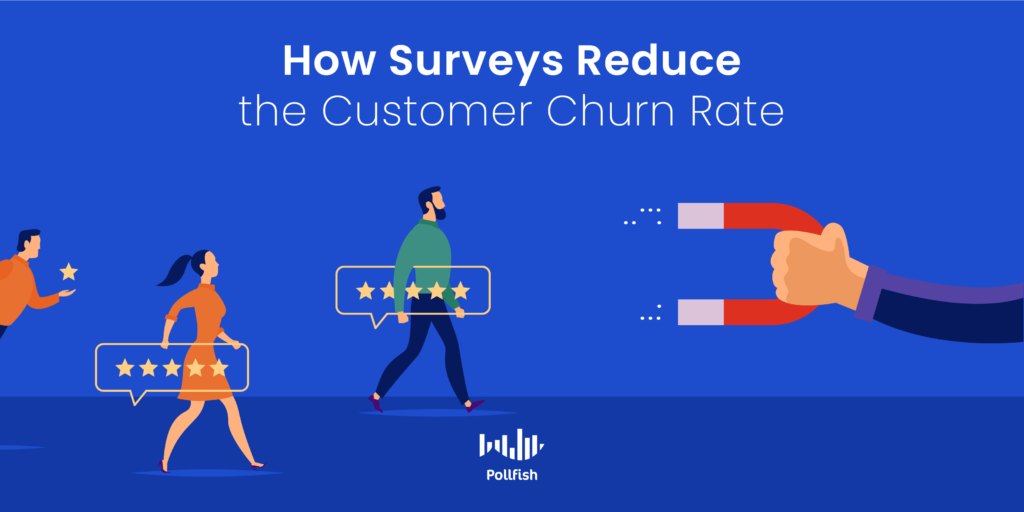Understanding the Customer Churn Rate and Using Surveys to Lower It

The customer churn rate is a crucial metric that all businesses must measure, as customer churn is a grim reality that businesses contend with regularly. In fact, two-thirds of companies have a customer churn rate above 5%.
Also referred to as customer attrition, defection or turnover, this metric gauges the unfavorable aspect of the loss of business with customers, users, vendors, revenue, or other factors within a period of time.
Commonly used in SaaS market research, it is used to measure the percentage of customers who unsubscribe from a SaaS product in a given period of time. However, this metric is crucial to measure in all industries.
This rate ought to be kept low, as churn usually indicates customer dissatisfaction or the availability of affordable alternatives. This is hugely problematic, as the customer is king; 43% of customers spend more money on brands they’re loyal to. Additionally, acquiring a new customer costs 5 times more than retaining an existing customer. Thus, businesses should retain their loyal customers.
This article expounds on the customer churn rate, its importance, its average across various industries, its calculation and how surveys can lower it.
Understanding the Customer Churn Rate
As its name suggests, this rate is a calculation of customer churn. Before diving into the metric, businesses should understand the meaning of customer churn.
Customer churn refers to the number of customers or subscribers who stop using a service during a given time period. There are a number of ways that customer churn affects a business, depending on its nature. These include:
- An account closure
- A subscription cancellation
- A non-renewal of a contract or service agreement
- A consumer switching to another service provider
- The cancellation of a contract midway through it or before completion
The customer churn rate (CCR) is therefore a metric that calculates the total number of customers a business has lost during a specific period. Therefore, it is the antithesis of the customer retention rate.
The customer churn rate is typically used to measure churn in businesses that run on a contractual or subscription-based product or service offering. As such, this term is chiefly associated with companies that operate on a subscription basis, such as SaaS companies.
referred to as the proportion of contractual (or subscribed) customers who terminate their contractual relationships/subscriptions with a company in a given timeframe. In this context, the term is primarily associated with companies operating on a subscription basis.
The Importance of the Customer Churn Rate

Businesses should measure their customer churn rate at regular intervals, as it is an important metric.
Firstly, its indication of lost customers directly ties into lost revenue. When a company loses customers, it negatively affects its bottom line. In this way, a high churn limits a business’s growth potential. Additionally, a significant churn rate always incurs financial difficulties of some degree.
Another reason it is so important to study and improve customer churn is that it is far more expensive to acquire new customers than it is to retain existing ones. In fact, acquiring a new customer costs 5 times more than retaining an existing one. As such, a business’s customer acquisition cost (CAC) is going to be more expensive than its customer retention rate (CRR).
Therefore, when a business loses existing customers, it will have to grapple with both the loss of revenue and business opportunities, coupled with the need to spend more on acquiring customers to make up for those that have churned.
As such, businesses must rein in their customer churn rate — and in order to do so, they have to keep track of it.
Studying this rate also involves keeping tabs on the competition, another critical area of maintaining business success. This is because the CCR can increase when competitors launch new and/or less expensive products, which may entice customers to churn and switch to them.
This dampens customer loyalty for obvious reasons and for some customers, can be a permanent switch to another brand. The ability to predict the churn rate is necessary for a company’s long-term success. Thus, businesses should gauge their churn rate and control it whenever possible.
How to Calculate the Customer Churn Rate
There are multiple ways to calculate the customer churn rate. This metric is typically presented as a percentage of either lost revenue or customers lost within a period of time. The following explains the CCR calculation:
To calculate a company’s churn rate, first, you must choose a period of time to evaluate and identify the following values:
- The number of customers at the start of a period (X)
- The number of customers lost during the period (Y)
Then, use the following churn rate formula to determine your customer churn rate (Z), expressed as a percentage.
Customer Churn Rate Formula
CCR = (Y / X) x 100
CCR = (number customers churned in a period / number of customers at the beginning of the period) X 100
For example, if a business had 200 existing customers at the start of Q3 and lost 20 customers by the end of Q3, it would calculator its churn rate as such:
CCR = (20/200) x 100
CRR = 0.1 x 100
CRR = 10%
This means that this business has a quarterly customer churn rate of 10% for Q3.
Aside from the number of lost customers, there are other churn metrics to plug into the customer churn rate formula. Whether or not these metrics are worth using to calculate the CCR is completely up to the business in question. It will depend on the nature of the business and its performance metrics needs.
Other churn metrics that businesses can use include the following:
- recurring revenue lost
- percentage of customers lost during a specific period
- decreased engagement product engagement
- percentage of revenue lost
- other variables specific to their product and business.
The more granular a company is with its customer churn analysis, the more effective it can be when working to reduce the churn rate and keep its customers.
Ideal Versus Poor Customer Churn Rate Benchmarks
All businesses undergo churn, even those that are new and/or are experiencing a solid subscription rate with no current turnover.
How can businesses distinguish between a good and bad churn rate? There are certain existing benchmarks for this. The most ideal, but unrealistic churn rate is 0%, as no business profits when a customer churns.
Given that it is virtually impossible to maintain a 0% churn rate, there are certain practical benchmarks that businesses can aim for. The following lists both ideal and poor CRR benchmarks that businesses ought to know:
- The ideal churn rate is 5-7%.
- This is considered the proper rate for mature and well-established SaaS companies that target enterprises.
- For early-stage businesses, the monthly churn should be closer to 5%.
- A churn rate above 10% is a critical warning that a business is poorly faring in customer retention.
- It signifies the need to change the customer experience (CX).
- A high CCR is over 10%, signifying that a business is operating at an unsustainable rate.
- It usually means that marketing efforts/ resources are used for acquiring customers rather than retaining them.
- When a business has a high churn rate, it must examine how it forms and fosters its customer relationships.
The Customer Churn Rate Across Industries
The CCR varies across industries and is highly likely to vary from one company to the next. Businesses should have an overview of how the churn rate fares in their industry and others. The following lists the average customer churn rate across several major industries:
- General retail: 24%
- Online retail: 22%
- Financial: 25%
- Telecommunications: 21%
- Travel: 18%
- Big box electronics: 11%
- Cable: 25%
- SaaS: 4.79%
How Surveys Can Lower Customer Churn Rate
Survey research can be used for a variety of purposes, which include lowering this unfortunate metric. This is because reinforcing strong business relationships with customers is a must in order to decrease the CCR. The most potent way to achieve this goal is by understanding your target market. Surveys allow businesses to do so in a quick and efficient manner.
Surveys allow businesses to examine their customers on an in-depth level, as surveys provide them with anonymity and speed, unlike survey panels and focus groups, which are not anonymous and are typically more time-consuming.
Given that surveys can address a wide range of topics, from customer satisfaction, to customer aversions, to customer buying behavior, brands can gain a wide swath of insights that support various campaigns.
Whether a business seeks to adjust its pricing strategy, partake in customer development before releasing a new product or improve its brand visibility, surveys provide the strongest means for obtaining customer feedback and insights.
Essentially, surveys allow businesses to understand their customers in relation to numerous business topics and concerns, while also providing them the opportunity to improve their strategies across functions, such as marketing, advertising and beyond. When businesses are in lockstep with their customers, they are far less likely to disappoint them.
Thus, businesses that know how to cater to their customers are poised to satisfy and delight them, thereby lowering their customer churn.
Using the Best Online Survey Platform to Reduce Churn

Customer churn can occur within even the most loyal of customers, especially in a highly competitive landscape. Understanding what causes formerly loyal customers to abandon ship is much-needed to sustain business growth.
While survey research is crucial, all online survey platforms are not identical in function, interfaces, data quality and ease of use. A strong online survey tool ought to excel in all regards and more.
For example, a useful online survey platform should incorporate RDE (random device engagement sampling) in order to capture respondents in their natural digital habitats and in a completely randomized manner, as well as include artificial intelligence that performs quality checks to ensure the highest quality of customer data.
Businesses should choose their survey software wisely, should they seek to lower their churn rate and improve on many other business fronts.
Pollfish Marketing Team
Ready to Try Pollfish?
Create your survey with AI, target high-quality respondents starting at $0.95 per complete, and start getting results in just minutes in real-time. From running a simple product concept survey to managing a constant stream of trackers for dozens of clients in dozens of countries, we’ve got you.
